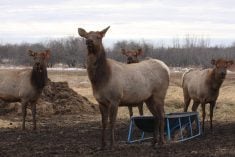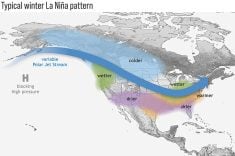The highlight of the National Farmers Union year was the so-called Mega Brief – an NFU document that refutes the assumption that European subsidies created the farm income crisis.
The Mega Brief concluded that the real cause of the farm income crisis is an imbalance of market power, and that agriculture profits need to be redistributed from corporations to family farms.
NFU vice-president Fred Tait told the annual convention that the phones started ringing when the Mega Brief was released in February and didn’t stop until August. Board members and executives distributed hundreds of copies of the document.
Read Also

Saskatchewan throne speech promises strong economy
Saskatchewan’s legislative agenda for the coming year will focus on meeting the challenges of new world trading relationships, said the speech from the throne.
A couple of the members attending the meeting called it the most important paper the NFU has produced in 31 years.
It was presented to standing committees of both the Senate and the House of Commons in February and March.
The document led to an NFU proposal to solve the farm income crisis, which was unveiled in August. The plan calls for the world’s five major grain exporters to take three percent of their productive land out of production each year until the price of grain doubles.
Despite a lack of interest from the federal government, the organization is still pushing hard for the land set-aside program.
It’s the message NFU president Cory Ollikka delivered to reporters attending the first day of the four-day annual convention.
“It has a better chance of succeeding than the current tack and that’s to continue to beat (our) heads against the brick wall of European subsidies,” Ollikka said.
“Just the rumor that that type of an agreement to set aside land is in the works would probably spark the market to respond.”
He said there is political unwillingness to undertake a set-aside program in Canada, but programs are already in place in the United States and the European Union.
More than 36 million acres of environmentally fragile farmland have been set aside under the U.S. Conservation Reserve Program. The EU’s Arable Areas Payments Program required a 10 percent set aside for the 1999-00 crop year.
The NFU believes Canada could persuade both governments to commit to a larger, multinational program. But the group is having a tough time persuading agriculture minister Lyle Vanclief to buy into the concept.
“We’ve passed it by the minister. We know the minister has it. The minister has refused to meet with us on it. I don’t know if he had election on the brain or what.”
But the plan has received an influential endorsement that could get it noticed. Saskatchewan Agriculture minister Clay Serby told convention goers that he wrote Vanclief three weeks ago asking him to review the proposal.
“I think the NFU set-aside proposal is an idea the federal government needs to take a close look at,” Serby said.
“A land set-aside is a really good idea and a wonderful option to reduce supply, but you have to have everybody on board. You can’t have Canada doing a set-aside and the Europeans and the Americans not.”
Ollikka said he is pleased that Serby likes the idea and encouraged him not to rest on his laurels.
“I hope he makes a very strong case for this type of a proposal and I hope the federal minister will respond and direct his department accordingly.”















